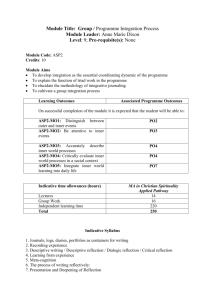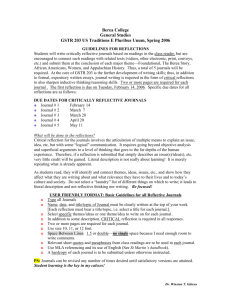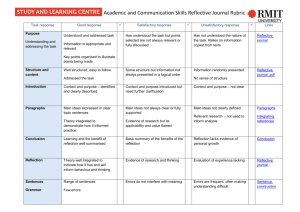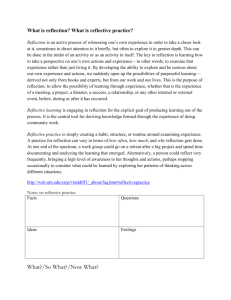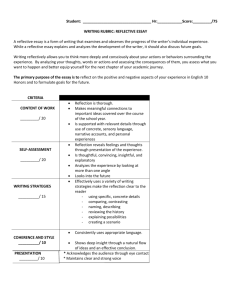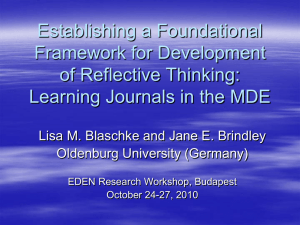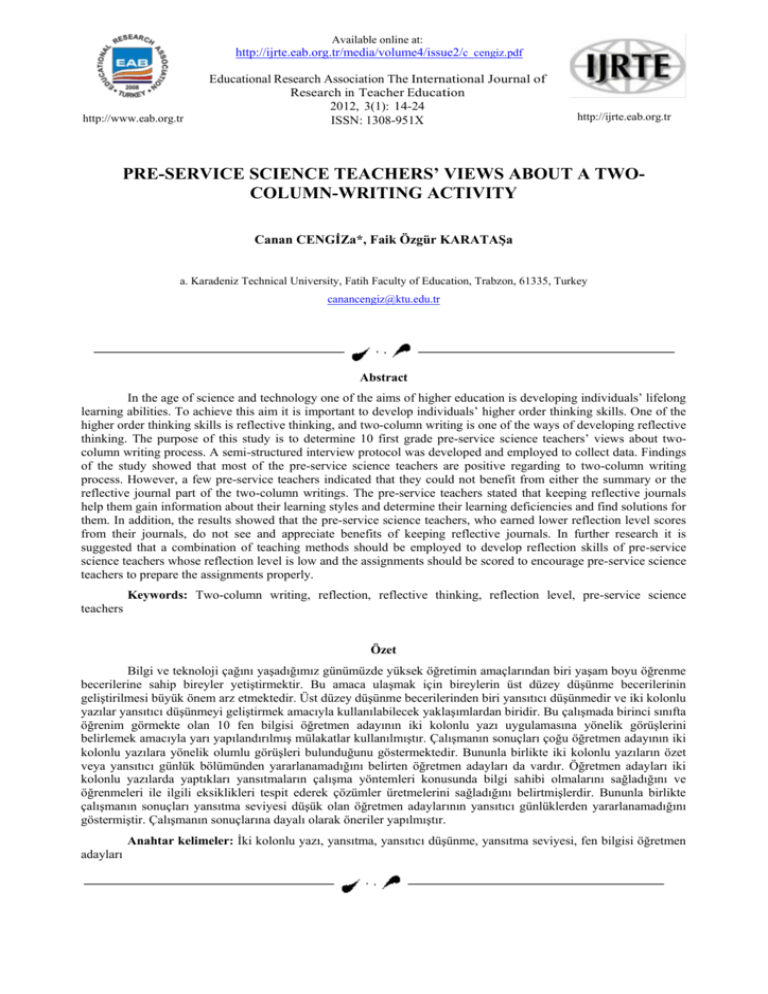
Available online at:
http://ijrte.eab.org.tr/media/volume4/issue2/c_cengiz.pdf
http://www.eab.org.tr
Educational Research Association The International Journal of
Research in Teacher Education
2012, 3(1): 14-24
ISSN: 1308-951X
http://ijrte.eab.org.tr
PRE-SERVICE SCIENCE TEACHERS’ VIEWS ABOUT A TWOCOLUMN-WRITING ACTIVITY
Canan CENGİZa*, Faik Özgür KARATAŞa
a. Karadeniz Technical University, Fatih Faculty of Education, Trabzon, 61335, Turkey
canancengiz@ktu.edu.tr
Abstract
In the age of science and technology one of the aims of higher education is developing individuals’ lifelong
learning abilities. To achieve this aim it is important to develop individuals’ higher order thinking skills. One of the
higher order thinking skills is reflective thinking, and two-column writing is one of the ways of developing reflective
thinking. The purpose of this study is to determine 10 first grade pre-service science teachers’ views about twocolumn writing process. A semi-structured interview protocol was developed and employed to collect data. Findings
of the study showed that most of the pre-service science teachers are positive regarding to two-column writing
process. However, a few pre-service teachers indicated that they could not benefit from either the summary or the
reflective journal part of the two-column writings. The pre-service teachers stated that keeping reflective journals
help them gain information about their learning styles and determine their learning deficiencies and find solutions for
them. In addition, the results showed that the pre-service science teachers, who earned lower reflection level scores
from their journals, do not see and appreciate benefits of keeping reflective journals. In further research it is
suggested that a combination of teaching methods should be employed to develop reflection skills of pre-service
science teachers whose reflection level is low and the assignments should be scored to encourage pre-service science
teachers to prepare the assignments properly.
Keywords: Two-column writing, reflection, reflective thinking, reflection level, pre-service science
teachers
Özet
Bilgi ve teknoloji çağını yaşadığımız günümüzde yüksek öğretimin amaçlarından biri yaşam boyu öğrenme
becerilerine sahip bireyler yetiştirmektir. Bu amaca ulaşmak için bireylerin üst düzey düşünme becerilerinin
geliştirilmesi büyük önem arz etmektedir. Üst düzey düşünme becerilerinden biri yansıtıcı düşünmedir ve iki kolonlu
yazılar yansıtıcı düşünmeyi geliştirmek amacıyla kullanılabilecek yaklaşımlardan biridir. Bu çalışmada birinci sınıfta
öğrenim görmekte olan 10 fen bilgisi öğretmen adayının iki kolonlu yazı uygulamasına yönelik görüşlerini
belirlemek amacıyla yarı yapılandırılmış mülakatlar kullanılmıştır. Çalışmanın sonuçları çoğu öğretmen adayının iki
kolonlu yazılara yönelik olumlu görüşleri bulunduğunu göstermektedir. Bununla birlikte iki kolonlu yazıların özet
veya yansıtıcı günlük bölümünden yararlanamadığını belirten öğretmen adayları da vardır. Öğretmen adayları iki
kolonlu yazılarda yaptıkları yansıtmaların çalışma yöntemleri konusunda bilgi sahibi olmalarını sağladığını ve
öğrenmeleri ile ilgili eksiklikleri tespit ederek çözümler üretmelerini sağladığını belirtmişlerdir. Bununla birlikte
çalışmanın sonuçları yansıtma seviyesi düşük olan öğretmen adaylarının yansıtıcı günlüklerden yararlanamadığını
göstermiştir. Çalışmanın sonuçlarına dayalı olarak öneriler yapılmıştır.
adayları
Anahtar kelimeler: İki kolonlu yazı, yansıtma, yansıtıcı düşünme, yansıtma seviyesi, fen bilgisi öğretmen
Pre-Service Science Teachers’ Views About A Two-Column-Writing Activity
Introduction
In the age of information and technology it is important to have lifelong learning skills to improve the
living conditions of individuals (Göksan,Uzundurukan & Keskin, 2009). Lifelong learning is a learning habit
and it means to understand the world and oneself. Lifelong learning is part of everyday life and it emphasizes
on constant development of individuals in all stages of their lives (Erdamar, 2010). The lifelong learning
movement was born to respond a number of deficiencies in education including inconsistency of objectives and
tools, paying attention to learning of information transmitted from books, lack of communication and
information technologies, negative perception towards learning because of the obsession to success and not
taking account of individual differences are some of these deficiencies (Budak, 2009). There are several skills
that need to be improved in order to maintain lifelong learning. These include reading, writing, mathematics
and other basic skills including listening, speaking, and personal skills such as communication with groups and
self-managing. Other important skills that are need for lifelong learning are thinking skills (Erdamar, 2010).
Bryce and Withers (2003) identified the key elements of lifelong learning for their project. One of these
elements emphasizes the importance of thinking: “Learning is about how to think rather than what to think”
(p.2). One of the higher order thinking skills is reflective thinking.
One of the aims of higher education is to help students became self-perpetuating and independent
learners. To achieve this aim paying attention to ‘reflection on learning’ is important (Stefani, Clarke &
Littlejohn 2010). Reflective thinking aims to create and develop positive feelings (Sönmez, 2010). It enables
students to take responsibility from their learning. Through reflective thinking, students think about their
experiences and become aware of their actions. Thus, it is expected that they would learn from their
experiences (Tok, 2008).Writing is associated with reflective thinking by many researchers because while
writing, individuals have an opportunity to think so that they can gain reflective skills and they can be aware
and participate more effectively in the learning process (Kozan, 2007).
Keeping learning journals is one of the most employed and researched technique that is also associated
with reflective thinking. In the related literature many positive effects of reflective journals were cited.
Amodeo (1996) reported that guided reflective journals had positive impact on college students’ writing
abilities and critical thinking. Moffitt (2000) indicated that it helps students to determine what they learn.
Similarly Grant et al. (2006) asserted that reflective journals increase the awareness of learning styles. Park
(2010) argued that keeping reflective journals helps students develop self-assessment; increases students’
interest and participation to the course; encourages students to take responsibility for their learning; makes
them more reflective in their studies; improves their awareness about how they study and how this effects their
learning. Few other studies, however, also reported that some of the participants did not find the journaling
process beneficial. Moffitt (2000), for example, studied with 10th grade students. He analyzed the students’
views about dialogue journals. Results of the study revealed that many students thought that journaling activity
was a waste of time. Langer (2002) analyzed adult learners’ opinions about keeping journals. Most of the adult
learners uttered that journal writing was an activity more appropriate for children not for grown-ups. They
found keeping journal as time-consuming activity.
There are different kinds of journals for different purposes including personal journals, two column
journals, dialogue journals, class journals, and journals of a particular subject area (Wilson & Jan, 1993). Two© Educational Research Association, All rights reserved. (IJRTE)
Sayfa 15
Pre-Service Science Teachers’ Views About A Two-Column-Writing Activity
column writing is relatively new approach to promote reflective thinking and learning science concepts. In
literature there are very few studies related to the two-column writings (Tok, 2008a;Tok, 2008b). Getting
students’ views about writing for learning or keeping a journal activity is very crucial to evaluate and properly
develop these activities. Thus, the aim of this study is to investigate pre-service science teachers’ views of twocolumn writing process. The guiding research questions for this study are:
1-What are pre-service science teachers’ views about two-column writing process?
2-How do pre-service science teachers’ views about reflective journals change based on their
reflection levels?
METHOD
The study was conducted at a large university located North Eastern part of Turkey. The participants
were 21 first-year pre-service science teachers who enrolled General Chemistry Laboratory II and volunteered
for the study. The study was conducted during Spring 2011. The General Chemistry Laboratory is held once a
week for two hours and the participants are required to perform one experiment each week regarding a general
chemistry topic. They were asked to prepare two-column writings every week after they perform their weekly
laboratory experiments for ten weeks. Most of the participants did not complete all ten writing assignments. In
the assignment, the pre-service science teachers were asked to divide a page into two equal columns. On the
left column, they were asked to write what they had known about the topic before the lesson and what they
learned during and after the experiment. On the right column, the participants were asked to reflect upon their
experiences by evaluating their own learning with their thoughts and feelings associated with the learning
process. The left side of the assignment was called the summary and the right side was called reflective journal.
In order to determine the pre-service science teachers’ level of reflection, each learning journal was examined
and graded from 1 to 4 based on Moon’s (2006) categorization (descriptive writing, descriptive account with
some reflection, reflective writing 1 and reflective writing 2). But, it was soon realized that it is difficult to fit
some of the journals into these categories, so we developed intermediate levels to describe the levels of
reflection. In another paper, we described this process in detail and presented pre-service science teachers’
reflection levels (Cengiz, Karataş & Yadigaroğlu, 2012). For the purpose of the current paper, the reflection
level of each pre-service science teacher was calculated by taking average scores of all collected journals. The
participants’ mean scores of reflection level and the number of completed assignments can be seen in Table 1.
In order to determine the participants’ views about two-column writing, semi-structured interviews
were conducted with ten pre-service science teachers. The interview protocol consisted of 5 open-ended
questions. Questions were aimed to determine whether the pre-service science teachers benefit from twocolumn writing activity and how they perceive reflection process. The protocol was reviewed by an expert in
chemistry education. The interviews took approximately 15 minutes to complete for each participant and each
interview was audio-recorded. The interview data were transcribed verbatim by the first researcher. The
transcriptions were organized first to get rid of irrelevant data. Then, each participant’s views were analyzed to
establish rich and thick descriptive cases.
© Educational Research Association, All rights reserved. (IJRTE)
Sayfa 16
Pre-Service Science Teachers’ Views About A Two-Column-Writing Activity
RESULTS
The results based on the analysis of the data collected from the participants’ reflective journals and
interviews are presented in two parts. In the first part, the average reflection level of the pre-service science
teachers is shown. In the second part of the results section, the pre-service teachers’ ideas about the twocolumn writing process are presented.
Table 1. Pre-service science teachers reflection level and completed assignment numbers
Average reflection level
Name
1,5 and below 1,5
Seçil
Ayşe
Tülay
Yaşar
Nilay
Candan
Sema
Gamze
Yılmaz
Suat
Above 1,5
Average reflection level/
Assignment number
1.38/ 8
1.10/ 5
1.50/ 9
1.50/ 6
1.65/ 10
1.94/ 9
1.61/ 9
1.72/ 9
1.94/ 9
1.75/ 4
Table 1 provides information about the number of two-column journals each pre-service teacher kept
and the average reflection level for them. As seen in Table 1, the pre-service teachers were divided into two
groups based on their average reflection levels: four pre-service teachers’ (Seçil, Ayşe, Tülay, Yaşar) average
reflection levels are 1.5 or smaller and the remaining participants’ (Nilay, Candan, Sema, Gamze, Yılmaz,
Suat) reflection levels are above 1.5. The reflection levels range from 1.10 to 1.94. Most of the participants
wrote eight or more journals, but Suat, for example, completed only four journals.
The data from the interviews were analyzed to describe each and every participant’s views so that we
can check whether there is a relationship between their views and their reflection levels. Thus, the participants’
views were presented separately beginning with Seçil.
Seçil
Seçil’s average reflection level is below 1.5. Seçil stated that she completed all of the writing tasks (8)
just a day earlier than it should be handed in. As seen in table 2, she thinks that she benefitted from preparing
the summary part of two column writing, but not from the reflective journal part. Seçil pointed out that if
journals were written realistically they could be effective for understanding whether one understands the
content or not. She also stated that grading the writings and providing feedbacks are the only way to make
students to write them effectively. Thus, it can be deducted from the interviews that Seçil did not consider
writing activities as serious homework. Seçil views writing reflections as expressing feelings, thoughts and the
experiences gained from the chemistry laboratory. It is understood from the interviews that Seçil’s self-efficacy
of writing a reflection journal is low: “…(Reflection) is something which I cannot do… something like diary…
I can’t do. I can’t transfer my feelings or experiences on a paper.” On the other hand, Seçil thought that the
feedbacks that were given by the instructor are very useful that they encourage her to figure out her
inadequacies related to chemistry content. She also indicated that the summary part of the writing assignment
© Educational Research Association, All rights reserved. (IJRTE)
Sayfa 17
Pre-Service Science Teachers’ Views About A Two-Column-Writing Activity
was very useful while studying for the exams which are great determiners of her grade for the laboratory. Seçil
also stated that using two column writings will be effective especially in numerical courses. Because of its
effectiveness, when she becomes a teacher she will give her students similar assignments in order to identify
her students’ inadequacies and address them right way.
Nilay
As seen in table 1 Nilay’s average reflection level is above 1.5. Nilay stated that she completed all of
the writing tasks (10) one day before the course in which she should be handed it in. She thinks that she
benefitted from both parts of the two column writing. She finds the assignments beneficial because it is
effective in remembering the subjects and they can be used as a summary notes while studying for the exams.
Nilay’s definition of reflection gives some clues about the benefits she gained by writing reflective journals:
“What is reflection? I discover myself that is what I understand from reflection… I try to change according to
it, for example I am taking notes (now), I see that I should keep notes or what happens if I don’t keep notes”
and she adds “What I have written to the right side clearly reveals what kind of a working method I applied
until now. The things you wrote about me (feedbacks) showed that I should do repetition and after writing them
(preparing the homework) I started to do daily repetition… At least it changed my studying habit… for example
I used to summarize the information two days before the exam and memorize them… now I start to study one
week before the exam.” Nilay stated that she wrote each feedback given from the instructor on a separate paper
and when she is done what she is advised to do she marks the related feedback as “done.” Thus it can be
deducted from the interviews that preparing the assignments increased her self-confidence: “I developed selfconfidence… I improved my lacking sides, my studying habit has been improved. Because of that I feel
comfortable, I can answer all kinds of questions that instructor asks me… because I can view questions from
different angles… Nowadays, I recognize that I am getting more interest in science. This is due to a little help
with your assignments and feedbacks. I used to interest in abstract things, now I started to interested in more
concrete things.” Nilay pointed out that the feedbacks changed her perspective by showing her the instructor’s
points of view. Nilay thinks that two column writing will effective in any courses. And she adds that when she
becomes a teacher she will ask her students to prepare similar assignments. She will ask them to write on
colorful papers and there will be a part which they can even draw.
Candan
Candan’s average reflection level is above 1.5. Candan stated that she completed some of her writing
tasks immediately after the session related to the task and completed the others one day before the session in
which she should be handed in. Candan thinks that she did not benefit from the summary part of the
homework: “I don’t think that the summary side of the writing has any benefits because I always take notes on
my book about our procedure in the laboratory. In my opinion, writing the summary part is just transferring
my notes to another place…” She views reflection as a process that shows both students and the teacher what is
gained by students and she explains the effect of writing reflective journal on her: “when I am doing a job I
always put my state of mind before science. I mean it is important whether I gained something from it. I put
emphasis on questions like ‘Why didn’t I gain something from it?’, ‘Is it about me or something else?” Candan
also stated that writing reflective journals help her relax. She pointed out that the feedbacks encourage her to
think about and recognize things. She also stated that two column writing is appropriate for laboratory courses:
© Educational Research Association, All rights reserved. (IJRTE)
Sayfa 18
Pre-Service Science Teachers’ Views About A Two-Column-Writing Activity
“(two column writing) yes it is appropriate for a laboratory course but I think it can’t be applied to physics or
maths…(In laboratory) we don’t just share scientific information, we also learn from and ask our friends and
other kinds of social sharing happens.” Candan indicated that when she becomes a teacher she may ask her
students to prepare two column writings but she also added that writing journal activity will not be on regular
basis. She noted that when students are asked to keep journals very often (e.g. weekly), it becomes boring.
Ayşe
Ayşe’s average reflection level is below 1.5. Ayşe stated that she completed her writing tasks at
different times of the week. As seen in table 2, she finds the summary part of the homework beneficial but the
reflective journaling unnecessary and she added that when she becomes a teacher she will not ask her students
to prepare reflective journals. When the definition of reflection was asked, she answered as “we write what we
learn”. Ayşe thinks that if the writings were graded they would be prepared carefully. On the other hand, she
also listed a few useful effects of the assignment on herself: “We take responsibility, you gave us a homework
and we should do it. At first, I tried to do it systematically but then I got bored and didn’t do it…” She pointed
out that it helped them to realize the experiment and the feedbacks helped them while preparing for the exams.
Ayşe also stated that she finds the homework appropriate for laboratory courses: “It is suitable for this course.
Moreover, it would be better if we kept journals in physics laboratory because we don’t pay attention to these
courses much but after we began keeping journals we started paying more attention… I don’t think that it can
be applied to other courses in which we learn theoretical knowledge…”
Tülay
Tülay’s average reflection level is 1.5. Tülay stated that she completed all of the writing tasks (9) just a
day earlier than it should be handed in. She thinks that both sides of the two-column writing activity are
effective in learning, but she claimed that she did not gain much from the reflection journal part. This might be
the reason why she could not keep journals as it was asked from them. She stated that this may be because this
is the first time that she prepares this kind of homework. She also thought that she is not capable of expressing
herself by writing. However, she pointed out that reflection is an activity that enables them to be aware of
themselves as well as help the instructor to get informed about what the students have learned. It is understood
from the interviews that writing the summary part was not a difficult task for her; she rather enjoyed doing it.
She also noted that the summary part of the writing help her recall the course concepts. On the other hand, she
indicated that writing the reflective journal is a hard task to do. Especially answering the question “what is your
aim” was difficult: “You asked us what are our aims? I believe that it is strange because I didn’t do something
like that before… Until now I have had easy targets… if we integrated this activity into our course at the
beginning of the first semester, it would be better…”Tülay pointed out that the feedbacks helped her revise her
homework. She thinks that two-column writing activity is appropriate for the chemistry laboratory and other
verbal courses. She is willing to employ this activity in her classes when she becomes a science teacher.
Sema
Sema’s average reflection level is 1.61. Sema stated that she completed her writing tasks at different
times of the week. She stated that preparing the summary part made her go over the subject and she finds it
useful for the exam. She indicated that writing reflective journal relaxes her. She explained what she
© Educational Research Association, All rights reserved. (IJRTE)
Sayfa 19
Pre-Service Science Teachers’ Views About A Two-Column-Writing Activity
understands from reflection as: “When we do an experiment and learn all concepts about it, I can question its
contributions to me and what has changed in my knowledge after doing the experiment.” She said when she
becomes a teacher she will ask her students to prepare two-column writing. She pointed out that this will help
her students identify the problems about her teaching and she can communicate with her students this way. She
thinks that two-column writing can be applicable in all courses.
Yaşar
Yaşar’s average reflection level is 1.5. Yaşar stated that he completed all of the writing tasks (6) a day
earlier than it should be handed in. He said he benefited from summary part of the homework but he did not
benefit from the reflective journal part and he thinks that this part has no effect on learning. He explained what
reflection as: “in journals we answer questions like, why we couldn’t be successful… reflection is explaining
what you have and haven’t learned in the course… and why?” Yaşar indicated that the summary part allowed
him to repeat the content and it was very useful for the exam. He thinks that the feedbacks and prompt
questions were well-put, but the students did not pay enough attention to them. So, they could not gain from
the feedback as much. Yaşar finds this application suitable for chemistry laboratory, but he does not consider
employing a similar approach when he becomes a teacher because he believes that middle school students
would not like keeping journals.
Gamze
Gamze’s average reflection level is 1.72. Gamze completed each writing task right after the laboratory
session. She believed that both parts of the two column writing are beneficial. She defined reflection as: “It is
reflective of your situation. If you want to declare your problems you can show them this way.” Summary part
help her consolidate her knowledge and it was beneficial for the exam. The feedbacks were encouraging her to
do research. The reflective journal enabled her to assess herself and to decide how to improve herself. She
plans to employ a similar activity when she becomes a teacher in order to diagnose her students. She claimed
that two-column writing is suitable for chemistry laboratory and she added “if you ask me in which laboratory
you have learned more? I would say chemistry rather than physics because I did not need to write in it (physics
laboratory).”
Yılmaz
Yılmaz’s average reflection level is above 1.5. Yılmaz stated that he sometimes completed the writing
tasks in the same day after the related laboratory session and sometimes a day earlier than it should be handed
in. It is deducted from the interviews that he benefited from both sides of the two column writings. He stated
that summary part makes the information persistent and the reflection journal part develops writing ability,
self-expression and enables one to pay more attention to the subject. Yılmaz also indicated that when he writes,
he realizes the issues that he has trouble which he needs to pay more attention to improve upon those issues. He
pointed out that feedbacks helped him improve his homework. Besides he indicated that the homework
connected him to the class and he felt enthusiasm for learning. He stated that when he becomes a teacher he
will give his students similar assignments. He thought that this activity is appropriate for chemistry laboratory
as well as physics: “we also take physics laboratory. It would be better if this assignment was also asked us
there because I think that learning doesn’t occur (there) as much as in chemistry laboratory…”
© Educational Research Association, All rights reserved. (IJRTE)
Sayfa 20
Pre-Service Science Teachers’ Views About A Two-Column-Writing Activity
Suat
Suat’s average reflection level is above 1.5. Suat completed the writing tasks at different times of the
week. Suat stated that he found the summary part of the assignment superficial and reflective journal part of the
writing assignment was far more useful. He pointed out that reflective journals helped him observe how he has
changed over time. Suat also thinks that when someone asks a question to himself/herself and writes an answer
for that question, then the answers is more honest. Suat explained the aim of reflection as providing answers
for the following questions: “(After the experiment) did I achieve my goals? How was my performance?... Why
didn’t I achieve my goal? Where did I make mistake?” Suat perceives the writing activity as a chance to see his
own development and to increase his motivation to study other courses. He mentioned during the interview that
his development is apparent when he compares his first and last assignment. The feedbacks, he continued,
given from the instructor are also very supportive for his development. He said that when he becomes a teacher
he will ask his students to prepare two-column writings. But, he thinks that answering the same questions every
week is boring, so he will make a few weekly changes. He also stated that the chemistry laboratory is the right
place to employ this activity.
The pre-service teachers’ views about the two-column writing activity are summarized in Table 2. The
two-column writing activity is considered as three dimensional processes for students; as writing summary,
writing reflective journals and receiving feedback.
Table 2. Pre-service teachers’ views about two-column writing
Dimensions of Writing
Summary
General views
Beneficial
Reflective journal
Partially beneficial
Useless
Beneficial
Feedback
Beneficial if prepared well
Useless
beneficial
I think that students not appreciative
Participants
Seçil, Ayşe, Tülay, Yaşar, Nilay,
Sema, Gamze, Yılmaz
Suat
Candan
Suat, Candan, Nilay, Sema, Gamze,
Yılmaz
Seçil, Tülay
Ayşe, Yaşar
Suat, Candan, Seçil, Ayşe, Tülay,
Nilay, Sema, Gamze, Yılmaz
Yaşar
f
8
1
1
6
2
2
9
1
DISCUSSIONS
A two-column writing activity can be thought as a three-way process: preparing summary, preparing
reflective journal and getting feedback. In this section of the study, the participants’ views regarding writing
summary, keeping reflective journal, and provided feedback are discussed respectively..
Most of the pre-service teachers found writing summary part beneficial. Especially they emphasized
the positive effect of preparing summary part on exams. Some of them pointed out that they used summaries as
course notes while preparing for exams. Some of them indicated that writing the summaries give them
opportunity to recite the laboratory content and some of them think that writing summary helps them remember
class content. However two participants did not find summary part as beneficial as reflective journal column.
The reason for this view might be attributed to the participants’ lack of experience and knowledge of how to
© Educational Research Association, All rights reserved. (IJRTE)
Sayfa 21
Pre-Service Science Teachers’ Views About A Two-Column-Writing Activity
prepare summaries. Because one of the participants, who did not see writing summary a beneficial activity,
defined summarizing process as transferring knowledge from one place to another. In her study, Deneme
(2009) examined 50 second-year pre-service English teachers’ summary writing strategies that they use while
they are writing summaries. She determined that the pre-service English teachers were weak in terms of
summary writing strategies they used. The reason for not being able to use summary writing strategies by the
pre-service teachers explained by the researcher as the pre-service teachers did not train about summary
writing. Similarly in this current study participants did not train about summary writing.
The pre-service science teachers have made several and various comments regarding the impact of the
reflective journal writing. First comment was about finding answer to the question: “What did I learn?”
Similarly, Moffitt (2000) reported that reflective journals help students determine what they learn or not. In the
related literature many positive aspects of reflective journals were cited: increasing the awareness of learning
styles (Grant et al., 2006); helping students develop self-assessment; increasing students’ interest and
participation to the course, encouraging students to take responsibility for their learning; making them more
reflective in their studies; improving their awareness about how they study and how this affects their learning
(Park, 2010); increasing students’ writing abilities and critical thinking (Amodeo, 1996). The findings of the
current study support these cited studies. In this study the pre-service science teachers indicated similar benefits
of reflective journals including gaining awareness about their study habits; enabling to find the source of the
problems about their learning; identifying lacking aspects and focusing on them; improving writing skills and
self-expression; and paying more attention to the course. One of the participants also indicated that while
writing reflective journals, one can judge himself or herself more honestly. Similarly, Malthouse and Barentsen
(2013) reported that reflective thinking forces us to be honest with ourselves.
Negative views regarding keeping journals, however, were also reported. Moffitt (2000), for example,
noted that many students indicated that keeping journals is a time wasting activity and these students could not
find a connection between learning science and keeping journals. Similary, we found that the participants
whose average reflection level scores are below 1.5 (see Table 1) stated that they did not get benefit from
keeping a reflective journal. The participants whose average reflection level scores are above 1.5 stated that
they benefited from this activity. Thus, it can be argued that the individuals with higher metacognitive skills
may gain more from keeping a reflective journal. In other words, one might be aware and get benefit from
reflective journals over a certain level of reflection. Furthermore, it can be said that writings with descriptive
characteristics have little or no effects on metacognition. Von Wright (1992) described two levels of reflection
and he indicated that second level reflection involves metacognitive learning skills (as cited in Grabinger &
Dunlap, 1995). The data gained from 2 out of 4 participants who said that they couldn’t benefit from the
reflective journals supports this argument. These participants indicated that reflective journals will be effective
when it is well prepared. Both students felt lacking of ability about writing reflective journals.
All of the participants found the feedbacks for the two-column journals beneficial except one. This
participant thought that his classmates did not utilized the feedbacks sufficiently. Other participants reported
the benefits of feedbacks as helping them think thoroughly and encouraging them to research, changing
perspective by showing the instructor’s point of view, giving them a chance to see their development, and
helping them improve the assignment.
© Educational Research Association, All rights reserved. (IJRTE)
Sayfa 22
Pre-Service Science Teachers’ Views About A Two-Column-Writing Activity
CONCLUSIONS AND RECOMMENDATIONS
The pre-service science teachers in this study generally convey positive views about summarizing
laboratory work and getting feedback from their writings. In the case of keeping reflective journals, the
participants uttered different opinions. It is found that the pre-service teachers seem to benefit more from the
journal keeping activity, when their reflection levels are high. In this study, the participants’ reflection levels
were generally low, so further research is needed to examine the relationship between the reflection levels of
participants and their views.
Many participants indicated that reflective journals help them gain awareness about their study habits
and methods, identify possible sources of learning problems, and determine their deficiencies so that they can
try to fix them.
There is another issue that we would like to bring on instructors’ attention. The interviews pointed out
that when assignments are not scored by the instructors, students do not pay enough attention to preparing
them. This situation should be taken into consideration in further research as well.
Last, but most important conclusion of this study is that the individuals cannot benefit from the
reflective journal as we expected unless they have certain level of reflection and reflective thinking skills.
Therefore, different methods should be employed (e.g. reflective conversations and prompt questions) to
develop reflection skills first in order to utilize benefits of keeping reflective journals.
Reference
Amodeo, J. L. (1996). The Effect of Guided Journal Writing on Community College Students of Technology,
Doctoral Dissertation, University of Toronto, Canada.
Bryce, J., & Withers, G. (2003). Engagaing Secondary School Students in Lifelong Learning. Melbourne:
Australian Council for Educational Research.
Budak, Y. (2009). Yaşam boyu öğrenme ve ilköğretim programlarının hedeflemesi gereken insan tipi. Gazi
Eğitim Fakültesi Dergisi, 29(3), 693-708.
Cengiz, C., Karataş, F. Ö., & Yadigaroğlu, M. (2013, 5-8 February). The investigation of pre-service science
teachers’ reflective journals. 5th World Conference on Educational Sciences. Sapienza University of
Rome, Italy.
Deneme, S. (2009). İngilizce öğretmen adaylarının özetleme stratejilerini kullanım tercihleri. Journal of
Language and Linguistic Studies, 5(2), 85-91.
Erdamar Koç, G. (2010). “Yaşam Boyu Öğrenme”. Eğitimde Yeni Yönelimler (edit: Özcan Demirel).
PegemYayıncılık, Ankara.
Göksan, T. S.,Uzundurukan, S., & Keskin, S. N. (2009, 6-7 Kasım). Yaşam Boyu Öğrenme ve Avrupa
Birliği’nin Yaşam Boyu Öğrenme Programları. 1. İnşaat Mühendisliği Eğitimi Sempozyumunda
sunulan bildiri, Antalya.
Grant, A., Kinnersley, P., Metcalf, E., Pill, R., & Houston, H. (2006). Students’ views of reflective learning
techniques: An efficacy study at a UK medical school. Med Educ, 40(4), 379-388.
© Educational Research Association, All rights reserved. (IJRTE)
Sayfa 23
Pre-Service Science Teachers’ Views About A Two-Column-Writing Activity
Kozan, S. (2007). Yansıtıcı Düşünme Becerisinin Kaynak Tarama ve Rapor Yazma Derslerindeki Etkisi.
Yayınlanmamış Yüksek Lisans Tezi, Selçuk Üniversitesi, Sosyal Bilimler Enstitüsü, Konya.
Langer, A. M. (2002). Reflecting on practice: using learning journals in higher and continuing education.
Teaching in Higher Education, 7(3), 337-351.
Malthouse, R. &Roffey-Barentsen, J. (2013). Reflective Practice in Education and Training. London: Sage
Publications.
Moffitt,G. (2000). Dialogue Journals In The Science Classroom: A Case Study, Master Thesis of Education,
TheUniversity of New Burnswick, Canada.
Moon, J. (2006). Learning Journals. New York:Routledge.
Park, C. (2003). Engaging students in the learning process: the learning journal. Journal of Geography in
Higher Education, 27(2), 183-199.
Sönmez, V. (2010). Öğretim İlke ve Yöntemleri. Ankara: AnıYayıncılık.
Stefani, L., Clarke, J., & Littlejohn, A. (2000). Developing a student-centred approach to reflective learning.
Innovations in Education and Training International, 37(2), 163-171.
Tok, Ş. (2008a). The effects of reflective thinking activities in science course on academic achievements and
attitudes toward science. Elementary Education Online, 7(3), 557-568.
Tok, Ş. (2008b).The impact of reflective thinking activities on student teachers’ attitudes toward teaching
profession, performance and reflections.Education and Science, 33(149), 104-117.
Wilson, J.,& Jan, L.W. (1993). Thinking for Themselves: Developing Strategies for Reflective Learning.
Australia: Eleanor Curtain Publishing.
© Educational Research Association, All rights reserved. (IJRTE)
Sayfa 24

